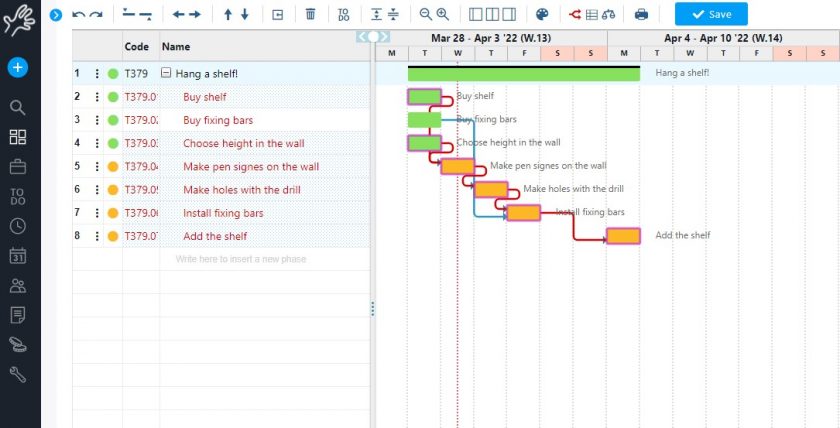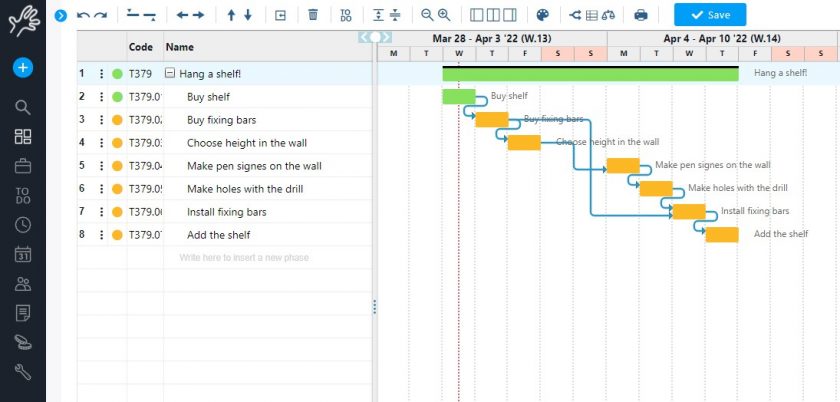The Critical Path Method (CPM) is an essential algorithm in project management, used to plan a set of project activities. Its purpose is to highlight the steps involved in the longest path that determines the project end date.
CONTENT
In this article we see how to implement CPM.
How to implement the Critical Path Method
To implement the Critical Path Method effectively, it is crucial to draw a network diagram illustrating all the necessary activities and their dependencies. Identifying the activities that form the critical path is crucial because these, being interconnected, define the minimum time required for the project to be completed.
Any delay in one of these activities can slow down the entire project.
To use this method, you must build the model by paying attention to:
- Define all projects’s phases
- Highlight dependencies between phases
- Calculate the duration of each phase correctly
The critical path analysis allows you to highlight what activities are “critical” but also those that can be delayed without increasing the project lifespan.
Critical Path Method: a practical example
If you have never used this methodology, let’s try to apply it to a simple example: imagine we have to install a shelf in the house.
First, you need to split the project into phases:
- Buy the shelf
- Buy the fixing bars
- Choose the wall and the height
- Make the signs on the wall
- Do the holes with the drill
- Install the fixing bars
- Mount the shelf
Once you define each steps, you can try to identify the dependencies: at a first analysis you immediately realize that some activities can not be started until others are completed, for example, you can not do holes with the drill until you make the signs on the wall, also the shelf can not be placed until the fixing bars are fixed. At the same time you see that the choice of the wall, the purchase of the shelf and fixing bars are activities that you can do in parallel. Here is the Gantt of activities with dependencies:

This type of activity can be easily planned using the Gantt diagrams that also shows the critical path calculation in red. The chart shows the sequential activities, they are in orange because suspended waiting for predecessor completion.
All these sequential activities are the fundamental steps that determine the length of your project. The critical path of the projects is the longest sequence of activities.
It is essential to pay close attention to phases on the critical path to manage the timing of your Gantt. For example, if you have a task that lasts 100 days, a 5-day delay on one of the sequential activities will result in a total delay of 5 days for the task.
Another important aspect to consider is the human resources availability, for example, we have said that some phases can be done in parallel such as buying fixing bars, shelf and choosing height in the wall, but these can be done in parallel only if you can count on three different resources available, in case you are alone to complete the project the Gantt changes drastically. Phases become all consecutive.

So, project critical path can be calculated according to tasks dependencies, but to determine task end dates it is necessary to identify the resources at your disposal and the correct duration of each phase. Only after analyzing these two aspects will you be able to handle project times by using a Gantt diagram and see a correct schedule.
From this simple example it is clear that critical path analysis is not trivial, this method is particularly used for complex but predictable activities.
In the real world, in fact, it is difficult to follow exactly the established plan, moreover, you can have external new requirements or constraints not considered at an early stage of planning.
In our example, if you did not find the fixing bars in the store and you have to order them online you could introduce a delay that could reflect on the overall project’s duration, even if this phase was not in the critical path.
Critical Path Method: the role of the project manager
The role of the project manager in this context becomes crucial.
An effective project manager not only supervises the sequence of activities, but also coordinates resources to ensure that the critical path can be completed smoothly.
The duration of activities on the critical path must be precisely managed, as any delay in these activities would directly reflect on the overall project timeline.
It is essential for the project manager to use tools such as Gantt charts to visualise progress and quickly adapt plans in response to any changes.
This careful control allows them to minimise the impact of delays and keep the project on schedule, making the best use of available resources and ensuring that deadlines are met.
It is also important that the project manager maintains constant communication with all project stakeholders. This not only helps keep everyone informed of progress, but also facilitates the collection of feedback that can lead to significant improvements in project management. The ability to quickly adapt plans in response to feedback or sudden changes is an invaluable quality in this profession.
With careful planning, dynamic resource management and effective communication, the project manager ensures that the project not only achieves its objectives on time, but also adapts to changes in the environment, thus maximising the chances of overall success.
Using Twproject for the Critical Path Method
To keep track of the progress of your plan at all times, you should therefore:
1. Update data frequently.
2. Carefully monitor the phases on the critical path, but also those outside it.
3. Keep resource availability under control.
This is why, being able to rely on software that manages easily updatable Gantt diagrams is essential: you will be able to enter dependencies quickly, as visualised in the previous images, but also enter durations and have the end date calculated automatically. An interactive Gantt chart will also allow you to quickly re-plan late tasks by showing you the changes immediately.
If you rely on project management software such as Twproject, which includes, in addition to the interactive Gantt with the critical path analysis, several tools for monitoring resources, you can easily manage the workload, so that you have the flexibility to intervene promptly on any critical issues and finally have everything under control.
Twproject not only simplifies the scheduling and monitoring of activities but also transforms the way information is shared and managed within the team.
By centralising information, each team member can access real-time updates, enabling a coordinated and timely response to any changes or issues that may arise.
In addition, the ability to visualise overall progress and relationships between different activities through interactive Gantt charts helps prevent bottlenecks and optimise workflows. The automatic update functionality of end dates, based on changes in previous activities, is particularly useful in dynamic project environments where time and resources may change frequently.
Relying on these advanced tools allows project managers to spend less time on manual data management and more time on strategic analysis and effective team leadership, thus raising the quality of the entire project management.
Finally, the integration of advanced project management software such as Twproject is crucial to ensure efficiency, responsiveness and successful project completion.




